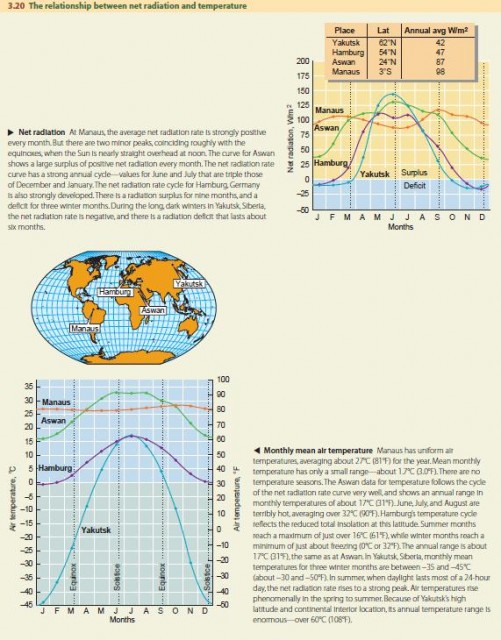Daily and Annual Cycles of Air Temperature
Let's turn to how, and why, air temperatures vary around the world. Insolation from the Sun varies across the globe, depending on latitude and season. Net radiation at a given place is positive during the day, as the surface gains heat from the Sun's rays. At night, the flow of incoming shortwave radiation stops, but the Earth continues to radiate longwave radiation. As a result, net radiation becomes negative. Because the air next to the surface is warmed or cooled as well, we get a daily cycle of air temperatures (Figure 3.16).
Why does the temperature peak in the midafternoon? We might expect it to continue rising as long as the net radiation is positive. But on sunny days in the early afternoon, large convection currents develop within several hundred meters of the surface, complicating the pattern. They carry hot air near the surface upwards, and they bring cooler air downwards. So the temperature typically peaks between 2 and 4 p.m. By sunset, air temperature is falling rapidly. It continues to fall more slowly throughout the night.
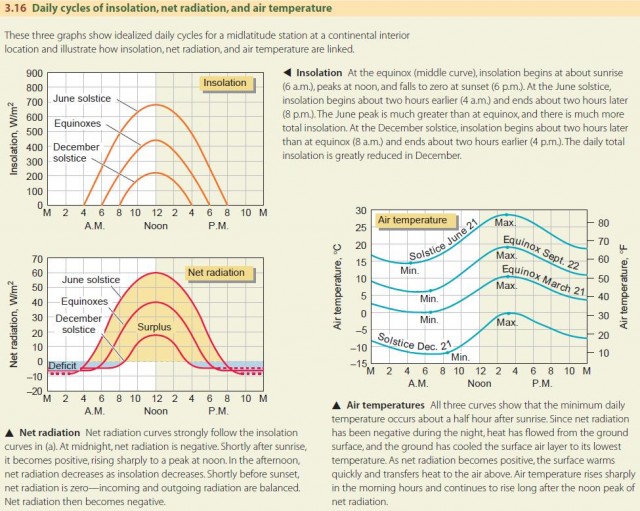
The height of the temperature curves varies with the seasons. In the summer, temperatures are warm and the daily curve is high. In winter, the temperatures are colder. The September equinox is considerably warmer than the March equinox even though net radiation is the same. This is because the temperature curves lag behind net radiation, reflecting earlier conditions.
LAND AND WATER CONTRASTS
There is another factor that influences the annual temperature cycle. If you have visited San Francisco, you probably noticed that this magnificent city has a unique climate. It's often foggy and cool, and the weather is damp for most of the year. Its cool climate is due to its location on the tip of a peninsula, with the Pacific Ocean on one side and San Francisco Bay on the other. A southward-flowing ocean current sweeps cold water from Alaska down along the northern California coast, and winds from the west move cool, moist ocean air, as well as clouds and fog, across the peninsula. This air flow keeps summer temperatures low and winter temperatures above freezing.
Figure 3.17 shows a typical temperature record for San Francisco for a week in the summer. Temperatures hover around 13°C (55°F) and change only a little from day to night. The story is very different at locations far from the water, like Yuma, in Arizona. Yuma is in the Sonoran Desert, and average air temperatures here are much warmer on the average—about 28°C (82°F). Clearly, no ocean cooling is felt in Yuma! The daily range is also much greater—the hot desert drops by nearly 20°C (36°F) from its daytime temperature, producing cool desert nights. The clear, dry air also helps the ground lose heat rapidly.
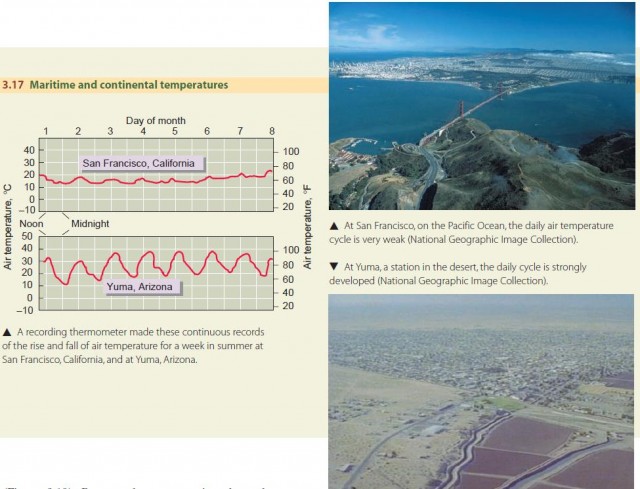
What is behind these differences? The important principle is this: the surface layer of any extensive, deep body of water heats more slowly and cools more slowly than the surface layer of a large body of land when both are subjected to the same intensity of insolation. Because of this principle, daily and annual air temperature cycles will be quite different at coastal locations than at interior locations. Together they make air temperatures above water less variable than those over land. Places located well inland and far from oceans will tend to have stronger temperature contrasts from winter to summer and night to day (Figure 3.18).
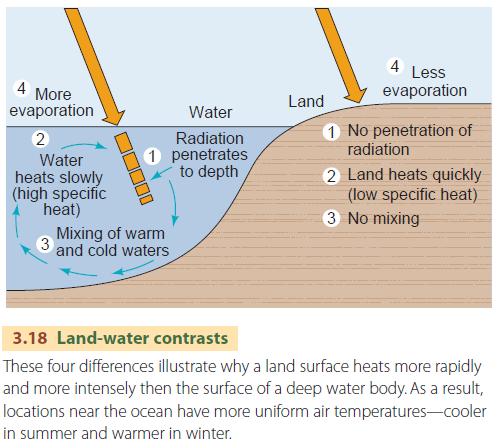
How does the land–water contrast affect the annual air temperature cycle? Let's look in detail at the annual cycle of another pair of stations—Winnipeg, Manitoba, located in the interior of the North American continent, and the Scilly Islands, off the southwestern tip of England, which are surrounded by the waters of the Atlantic Ocean (Figure 3.19). Because these two stations have the same latitude, 50° N, they have the same insolation cycle and receive the same potential amount of solar energy for surface warming.
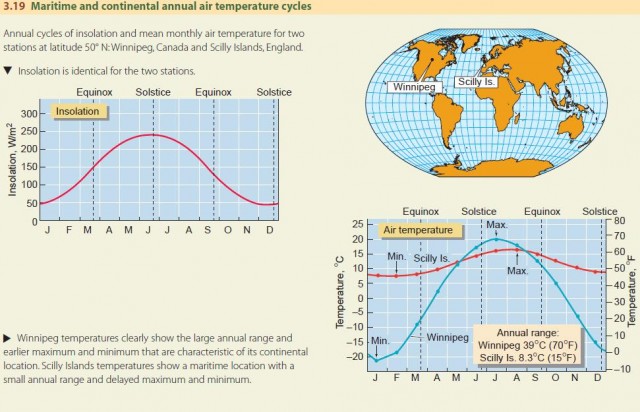
The temperature graphs for the Scilly Islands and Winnipeg show that the annual range in temperature is much larger for the interior station (39°C, 70°F) than for the coastal station (8°C, 14°F). The nearby ocean waters keep the air temperature at the Scilly Islands well above freezing in the winter, while January temperatures at Winnipeg fall to near ?20°C (?4°F).
Another important effect of the land–water contrast concerns the timing of maximum and minimum temperatures. Insolation reaches a maximum at the summer solstice, but it is still strong for a long period afterward, so that net radiation is positive well after the solstice. Therefore, the hottest month of the year for interior regions is July, the month following the summer solstice. The coldest month is January, the month after the winter solstice. The continued cooling after the winter solstice takes place because the net radiation is still negative even though the insolation has begun to increase.
Over the oceans and at coastal locations, maximum and minimum air temperatures are reached a month later than on land—in August and February, respectively.
Because water bodies heat or cool more slowly than land areas, the air temperature changes more slowly. This effect is clearly seen in the Scilly Islands graph, which shows that February is slightly colder than January.
ANNUAL NET RADIATION AND TEMPERATURE CYCLES
We have seen that location—maritime or continental—has an important influence on annual temperature cycles. But the largest effect is caused by the annual cycle of net radiation. Daily insolation varies over the seasons of the year, owing to the Earth's motion around the Sun and the tilt of the Earth's axis. That rhythm produces a net radiation cycle, which, in turn, causes an annual cycle in mean monthly air temperatures. Figure 3.20 examines the cycles of net radiation and temperature at four sites ranging from the Equator to the Arctic Circle.
